Report: Management and Organization of Barclays Bank
VerifiedAdded on 2021/11/09
|8
|1993
|357
Report
AI Summary
This report provides a comprehensive analysis of Barclays Bank's management and organization. It begins with an introduction to management principles and defines the context of the case study, Barclays Bank. The report then delves into the company's background, followed by an examination of its functional organizational structure, highlighting its advantages and disadvantages, especially in the context of Brexit. The report explores modern management approaches, particularly the contingency approach, and its relevance to Barclays' strategic decisions. Furthermore, it analyzes Barclays' strategic objectives, including the expansion strategy of its Ireland subsidiary, and applies Porter's Five Forces framework to assess the competitive landscape of the banking industry. The report concludes by summarizing the key findings and emphasizing the importance of strategic management in achieving business objectives. The analysis demonstrates how Barclays is adapting to the challenges and opportunities in the financial services sector, particularly in light of Brexit.
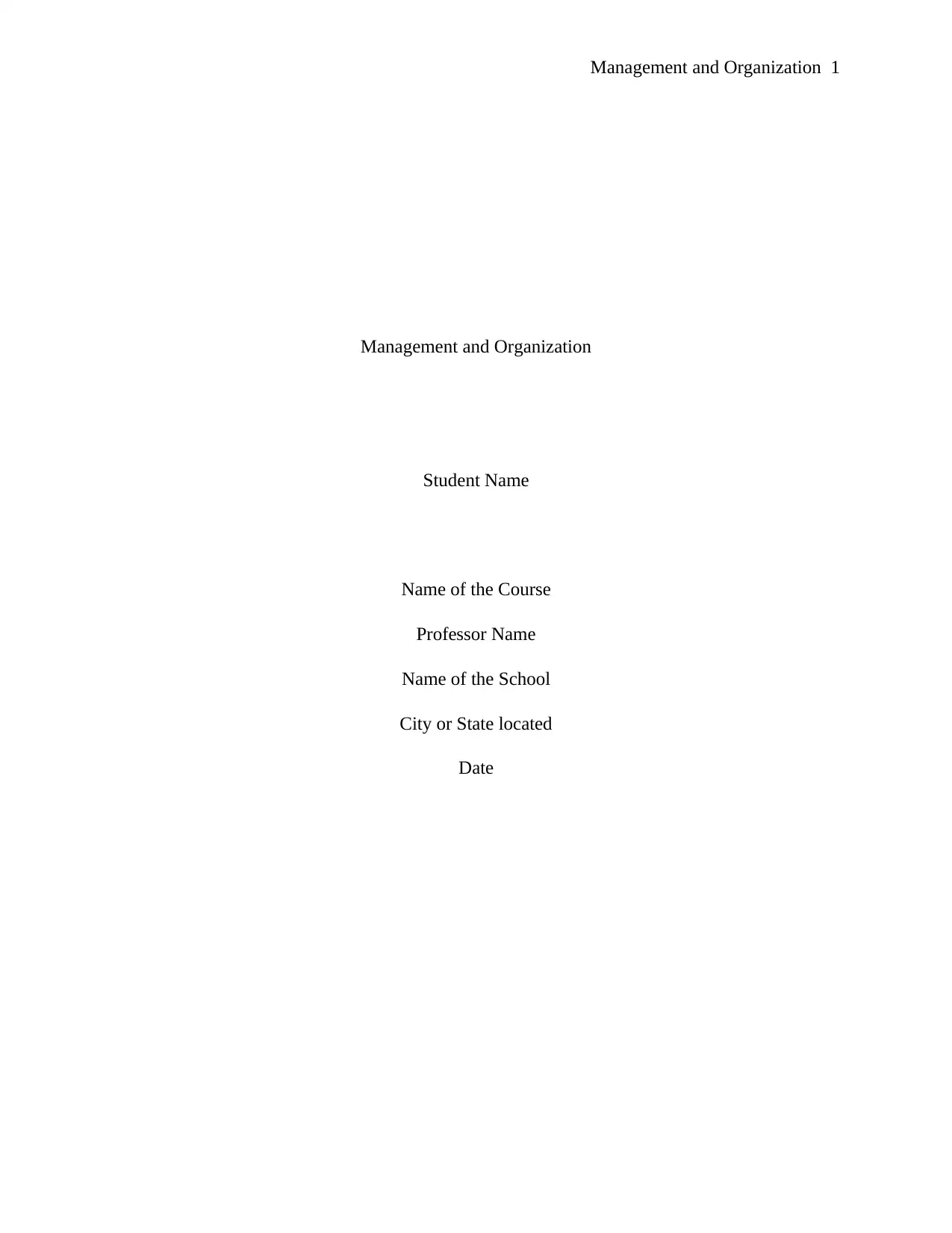
Management and Organization 1
Management and Organization
Student Name
Name of the Course
Professor Name
Name of the School
City or State located
Date
Management and Organization
Student Name
Name of the Course
Professor Name
Name of the School
City or State located
Date
Paraphrase This Document
Need a fresh take? Get an instant paraphrase of this document with our AI Paraphraser
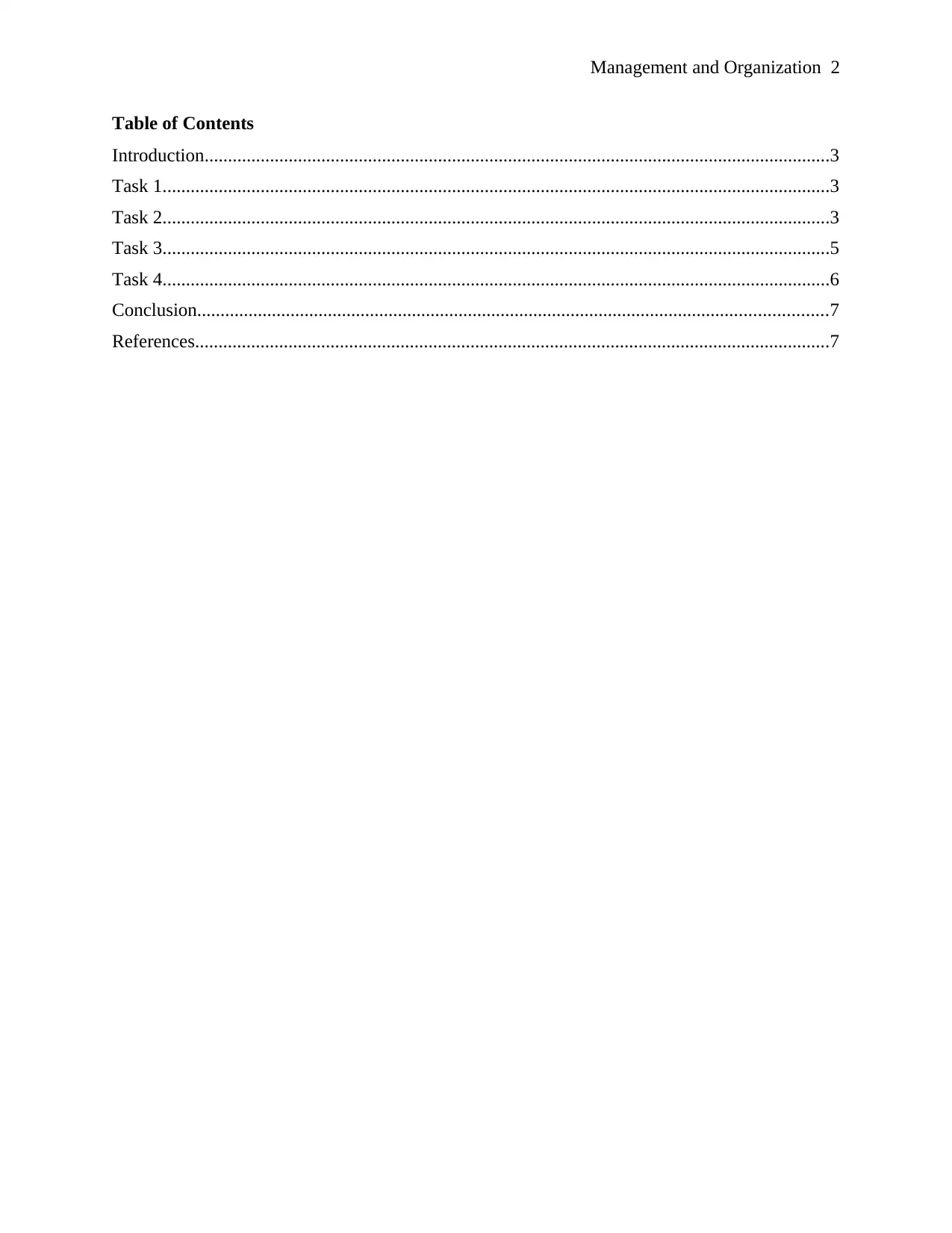
Management and Organization 2
Table of Contents
Introduction......................................................................................................................................3
Task 1...............................................................................................................................................3
Task 2...............................................................................................................................................3
Task 3...............................................................................................................................................5
Task 4...............................................................................................................................................6
Conclusion.......................................................................................................................................7
References........................................................................................................................................7
Table of Contents
Introduction......................................................................................................................................3
Task 1...............................................................................................................................................3
Task 2...............................................................................................................................................3
Task 3...............................................................................................................................................5
Task 4...............................................................................................................................................6
Conclusion.......................................................................................................................................7
References........................................................................................................................................7
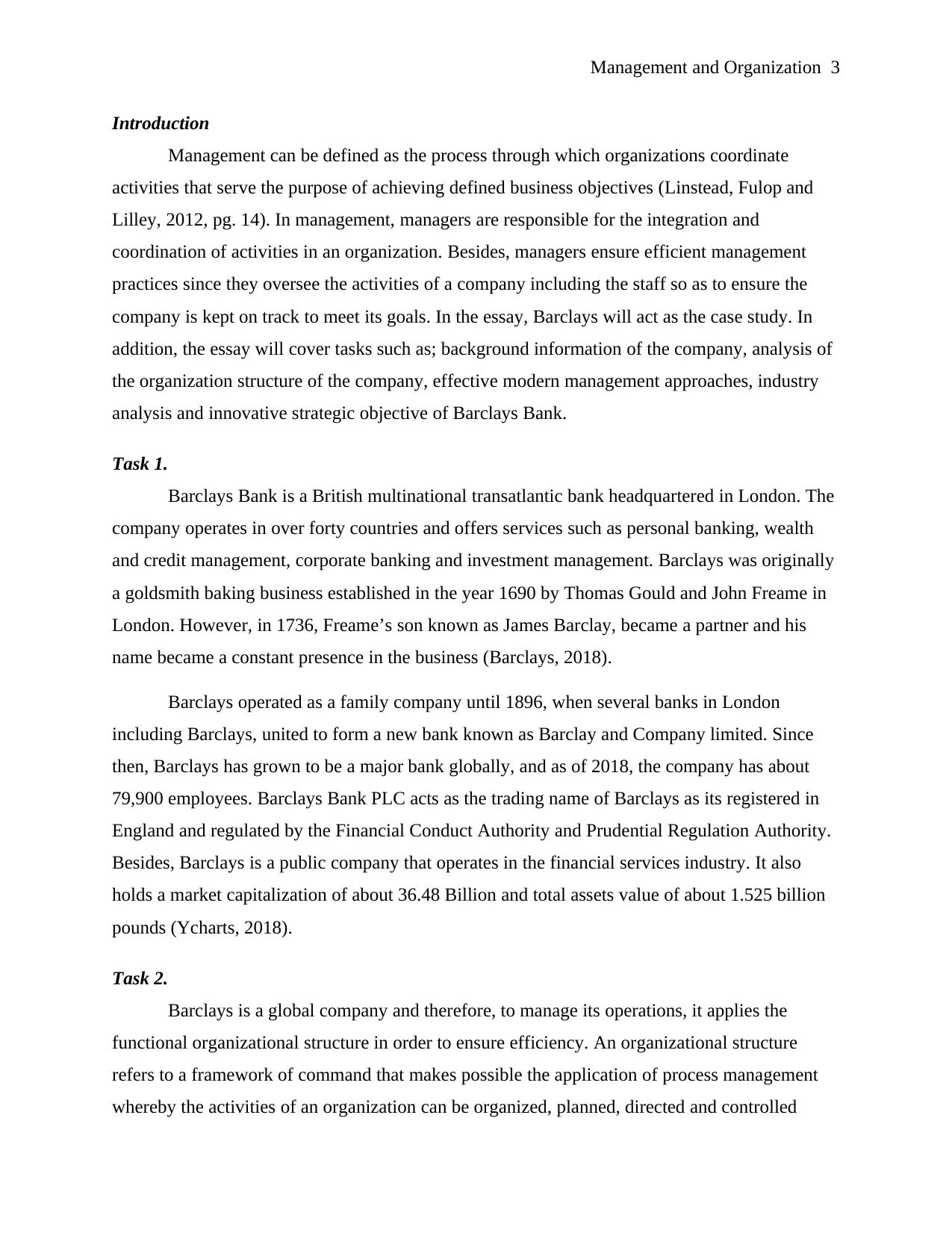
Management and Organization 3
Introduction
Management can be defined as the process through which organizations coordinate
activities that serve the purpose of achieving defined business objectives (Linstead, Fulop and
Lilley, 2012, pg. 14). In management, managers are responsible for the integration and
coordination of activities in an organization. Besides, managers ensure efficient management
practices since they oversee the activities of a company including the staff so as to ensure the
company is kept on track to meet its goals. In the essay, Barclays will act as the case study. In
addition, the essay will cover tasks such as; background information of the company, analysis of
the organization structure of the company, effective modern management approaches, industry
analysis and innovative strategic objective of Barclays Bank.
Task 1.
Barclays Bank is a British multinational transatlantic bank headquartered in London. The
company operates in over forty countries and offers services such as personal banking, wealth
and credit management, corporate banking and investment management. Barclays was originally
a goldsmith baking business established in the year 1690 by Thomas Gould and John Freame in
London. However, in 1736, Freame’s son known as James Barclay, became a partner and his
name became a constant presence in the business (Barclays, 2018).
Barclays operated as a family company until 1896, when several banks in London
including Barclays, united to form a new bank known as Barclay and Company limited. Since
then, Barclays has grown to be a major bank globally, and as of 2018, the company has about
79,900 employees. Barclays Bank PLC acts as the trading name of Barclays as its registered in
England and regulated by the Financial Conduct Authority and Prudential Regulation Authority.
Besides, Barclays is a public company that operates in the financial services industry. It also
holds a market capitalization of about 36.48 Billion and total assets value of about 1.525 billion
pounds (Ycharts, 2018).
Task 2.
Barclays is a global company and therefore, to manage its operations, it applies the
functional organizational structure in order to ensure efficiency. An organizational structure
refers to a framework of command that makes possible the application of process management
whereby the activities of an organization can be organized, planned, directed and controlled
Introduction
Management can be defined as the process through which organizations coordinate
activities that serve the purpose of achieving defined business objectives (Linstead, Fulop and
Lilley, 2012, pg. 14). In management, managers are responsible for the integration and
coordination of activities in an organization. Besides, managers ensure efficient management
practices since they oversee the activities of a company including the staff so as to ensure the
company is kept on track to meet its goals. In the essay, Barclays will act as the case study. In
addition, the essay will cover tasks such as; background information of the company, analysis of
the organization structure of the company, effective modern management approaches, industry
analysis and innovative strategic objective of Barclays Bank.
Task 1.
Barclays Bank is a British multinational transatlantic bank headquartered in London. The
company operates in over forty countries and offers services such as personal banking, wealth
and credit management, corporate banking and investment management. Barclays was originally
a goldsmith baking business established in the year 1690 by Thomas Gould and John Freame in
London. However, in 1736, Freame’s son known as James Barclay, became a partner and his
name became a constant presence in the business (Barclays, 2018).
Barclays operated as a family company until 1896, when several banks in London
including Barclays, united to form a new bank known as Barclay and Company limited. Since
then, Barclays has grown to be a major bank globally, and as of 2018, the company has about
79,900 employees. Barclays Bank PLC acts as the trading name of Barclays as its registered in
England and regulated by the Financial Conduct Authority and Prudential Regulation Authority.
Besides, Barclays is a public company that operates in the financial services industry. It also
holds a market capitalization of about 36.48 Billion and total assets value of about 1.525 billion
pounds (Ycharts, 2018).
Task 2.
Barclays is a global company and therefore, to manage its operations, it applies the
functional organizational structure in order to ensure efficiency. An organizational structure
refers to a framework of command that makes possible the application of process management
whereby the activities of an organization can be organized, planned, directed and controlled
⊘ This is a preview!⊘
Do you want full access?
Subscribe today to unlock all pages.

Trusted by 1+ million students worldwide
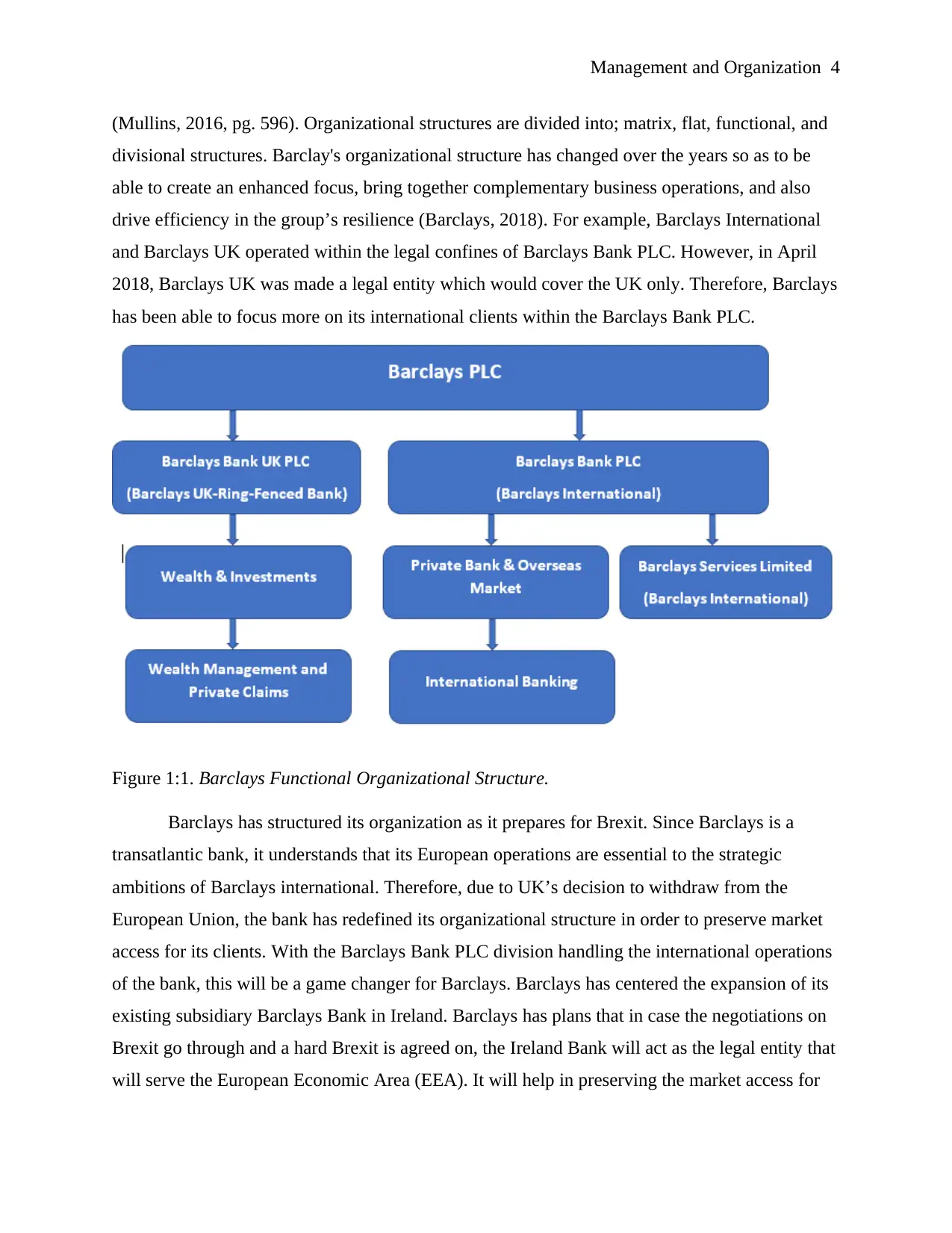
Management and Organization 4
(Mullins, 2016, pg. 596). Organizational structures are divided into; matrix, flat, functional, and
divisional structures. Barclay's organizational structure has changed over the years so as to be
able to create an enhanced focus, bring together complementary business operations, and also
drive efficiency in the group’s resilience (Barclays, 2018). For example, Barclays International
and Barclays UK operated within the legal confines of Barclays Bank PLC. However, in April
2018, Barclays UK was made a legal entity which would cover the UK only. Therefore, Barclays
has been able to focus more on its international clients within the Barclays Bank PLC.
Figure 1:1. Barclays Functional Organizational Structure.
Barclays has structured its organization as it prepares for Brexit. Since Barclays is a
transatlantic bank, it understands that its European operations are essential to the strategic
ambitions of Barclays international. Therefore, due to UK’s decision to withdraw from the
European Union, the bank has redefined its organizational structure in order to preserve market
access for its clients. With the Barclays Bank PLC division handling the international operations
of the bank, this will be a game changer for Barclays. Barclays has centered the expansion of its
existing subsidiary Barclays Bank in Ireland. Barclays has plans that in case the negotiations on
Brexit go through and a hard Brexit is agreed on, the Ireland Bank will act as the legal entity that
will serve the European Economic Area (EEA). It will help in preserving the market access for
(Mullins, 2016, pg. 596). Organizational structures are divided into; matrix, flat, functional, and
divisional structures. Barclay's organizational structure has changed over the years so as to be
able to create an enhanced focus, bring together complementary business operations, and also
drive efficiency in the group’s resilience (Barclays, 2018). For example, Barclays International
and Barclays UK operated within the legal confines of Barclays Bank PLC. However, in April
2018, Barclays UK was made a legal entity which would cover the UK only. Therefore, Barclays
has been able to focus more on its international clients within the Barclays Bank PLC.
Figure 1:1. Barclays Functional Organizational Structure.
Barclays has structured its organization as it prepares for Brexit. Since Barclays is a
transatlantic bank, it understands that its European operations are essential to the strategic
ambitions of Barclays international. Therefore, due to UK’s decision to withdraw from the
European Union, the bank has redefined its organizational structure in order to preserve market
access for its clients. With the Barclays Bank PLC division handling the international operations
of the bank, this will be a game changer for Barclays. Barclays has centered the expansion of its
existing subsidiary Barclays Bank in Ireland. Barclays has plans that in case the negotiations on
Brexit go through and a hard Brexit is agreed on, the Ireland Bank will act as the legal entity that
will serve the European Economic Area (EEA). It will help in preserving the market access for
Paraphrase This Document
Need a fresh take? Get an instant paraphrase of this document with our AI Paraphraser
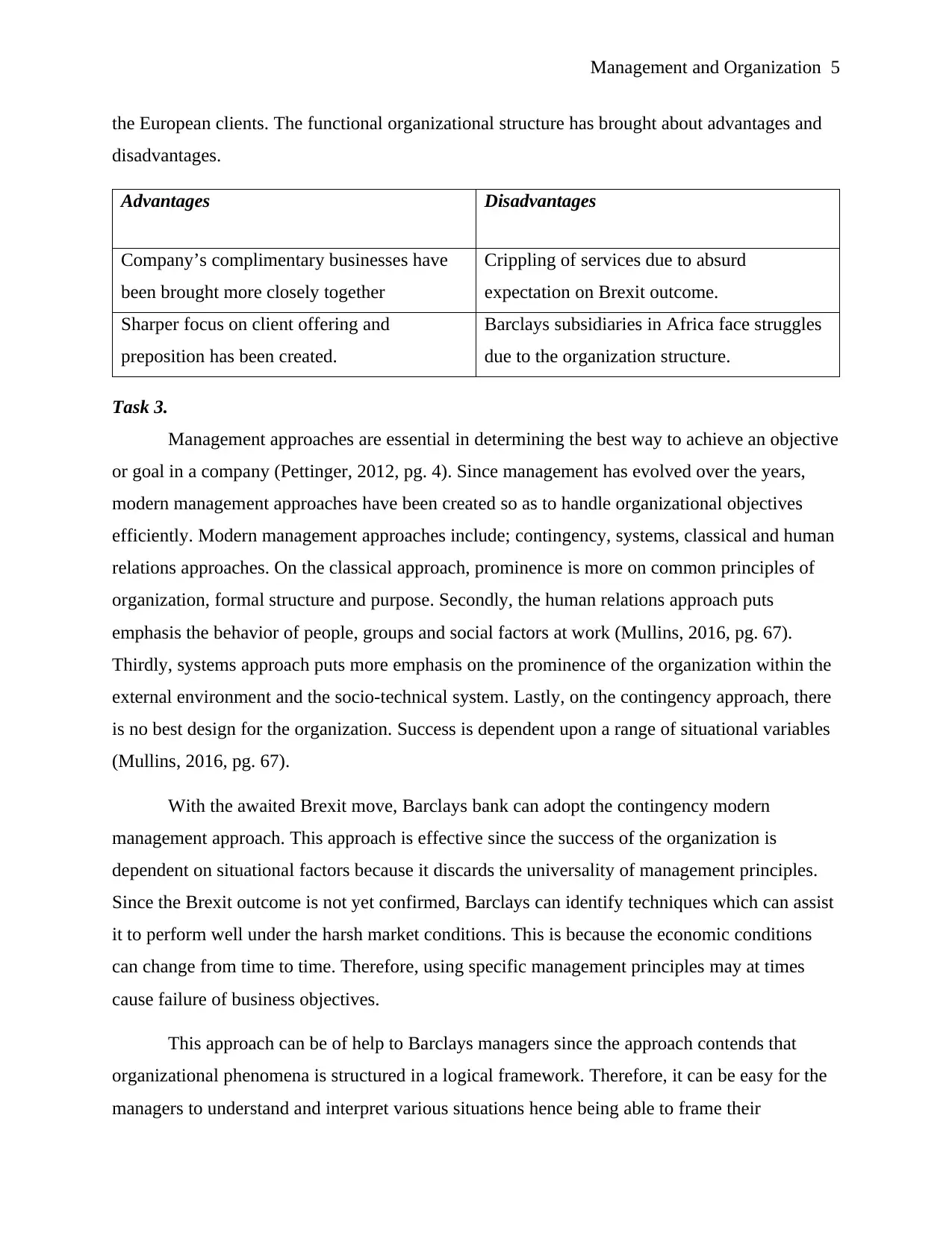
Management and Organization 5
the European clients. The functional organizational structure has brought about advantages and
disadvantages.
Advantages Disadvantages
Company’s complimentary businesses have
been brought more closely together
Crippling of services due to absurd
expectation on Brexit outcome.
Sharper focus on client offering and
preposition has been created.
Barclays subsidiaries in Africa face struggles
due to the organization structure.
Task 3.
Management approaches are essential in determining the best way to achieve an objective
or goal in a company (Pettinger, 2012, pg. 4). Since management has evolved over the years,
modern management approaches have been created so as to handle organizational objectives
efficiently. Modern management approaches include; contingency, systems, classical and human
relations approaches. On the classical approach, prominence is more on common principles of
organization, formal structure and purpose. Secondly, the human relations approach puts
emphasis the behavior of people, groups and social factors at work (Mullins, 2016, pg. 67).
Thirdly, systems approach puts more emphasis on the prominence of the organization within the
external environment and the socio-technical system. Lastly, on the contingency approach, there
is no best design for the organization. Success is dependent upon a range of situational variables
(Mullins, 2016, pg. 67).
With the awaited Brexit move, Barclays bank can adopt the contingency modern
management approach. This approach is effective since the success of the organization is
dependent on situational factors because it discards the universality of management principles.
Since the Brexit outcome is not yet confirmed, Barclays can identify techniques which can assist
it to perform well under the harsh market conditions. This is because the economic conditions
can change from time to time. Therefore, using specific management principles may at times
cause failure of business objectives.
This approach can be of help to Barclays managers since the approach contends that
organizational phenomena is structured in a logical framework. Therefore, it can be easy for the
managers to understand and interpret various situations hence being able to frame their
the European clients. The functional organizational structure has brought about advantages and
disadvantages.
Advantages Disadvantages
Company’s complimentary businesses have
been brought more closely together
Crippling of services due to absurd
expectation on Brexit outcome.
Sharper focus on client offering and
preposition has been created.
Barclays subsidiaries in Africa face struggles
due to the organization structure.
Task 3.
Management approaches are essential in determining the best way to achieve an objective
or goal in a company (Pettinger, 2012, pg. 4). Since management has evolved over the years,
modern management approaches have been created so as to handle organizational objectives
efficiently. Modern management approaches include; contingency, systems, classical and human
relations approaches. On the classical approach, prominence is more on common principles of
organization, formal structure and purpose. Secondly, the human relations approach puts
emphasis the behavior of people, groups and social factors at work (Mullins, 2016, pg. 67).
Thirdly, systems approach puts more emphasis on the prominence of the organization within the
external environment and the socio-technical system. Lastly, on the contingency approach, there
is no best design for the organization. Success is dependent upon a range of situational variables
(Mullins, 2016, pg. 67).
With the awaited Brexit move, Barclays bank can adopt the contingency modern
management approach. This approach is effective since the success of the organization is
dependent on situational factors because it discards the universality of management principles.
Since the Brexit outcome is not yet confirmed, Barclays can identify techniques which can assist
it to perform well under the harsh market conditions. This is because the economic conditions
can change from time to time. Therefore, using specific management principles may at times
cause failure of business objectives.
This approach can be of help to Barclays managers since the approach contends that
organizational phenomena is structured in a logical framework. Therefore, it can be easy for the
managers to understand and interpret various situations hence being able to frame their
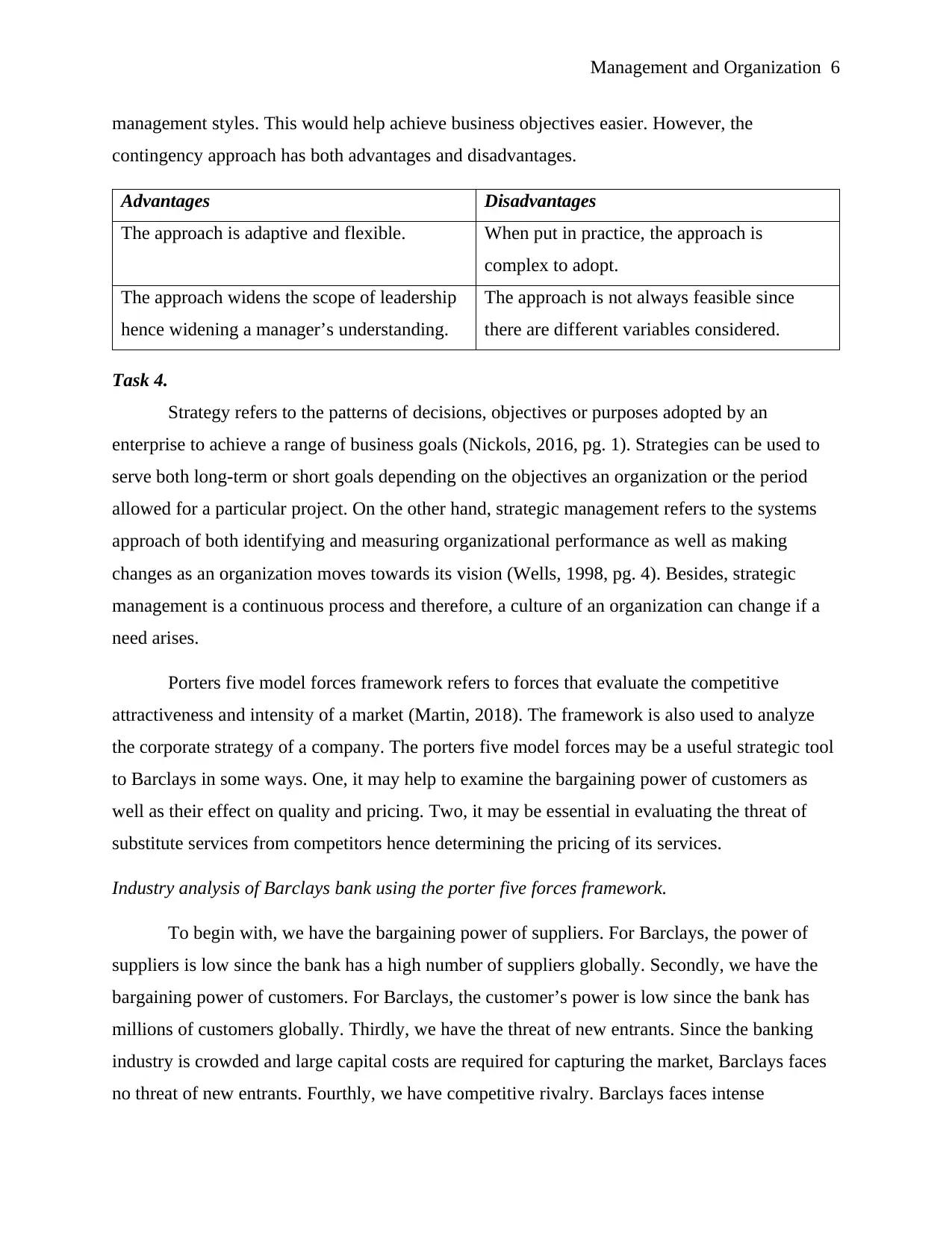
Management and Organization 6
management styles. This would help achieve business objectives easier. However, the
contingency approach has both advantages and disadvantages.
Advantages Disadvantages
The approach is adaptive and flexible. When put in practice, the approach is
complex to adopt.
The approach widens the scope of leadership
hence widening a manager’s understanding.
The approach is not always feasible since
there are different variables considered.
Task 4.
Strategy refers to the patterns of decisions, objectives or purposes adopted by an
enterprise to achieve a range of business goals (Nickols, 2016, pg. 1). Strategies can be used to
serve both long-term or short goals depending on the objectives an organization or the period
allowed for a particular project. On the other hand, strategic management refers to the systems
approach of both identifying and measuring organizational performance as well as making
changes as an organization moves towards its vision (Wells, 1998, pg. 4). Besides, strategic
management is a continuous process and therefore, a culture of an organization can change if a
need arises.
Porters five model forces framework refers to forces that evaluate the competitive
attractiveness and intensity of a market (Martin, 2018). The framework is also used to analyze
the corporate strategy of a company. The porters five model forces may be a useful strategic tool
to Barclays in some ways. One, it may help to examine the bargaining power of customers as
well as their effect on quality and pricing. Two, it may be essential in evaluating the threat of
substitute services from competitors hence determining the pricing of its services.
Industry analysis of Barclays bank using the porter five forces framework.
To begin with, we have the bargaining power of suppliers. For Barclays, the power of
suppliers is low since the bank has a high number of suppliers globally. Secondly, we have the
bargaining power of customers. For Barclays, the customer’s power is low since the bank has
millions of customers globally. Thirdly, we have the threat of new entrants. Since the banking
industry is crowded and large capital costs are required for capturing the market, Barclays faces
no threat of new entrants. Fourthly, we have competitive rivalry. Barclays faces intense
management styles. This would help achieve business objectives easier. However, the
contingency approach has both advantages and disadvantages.
Advantages Disadvantages
The approach is adaptive and flexible. When put in practice, the approach is
complex to adopt.
The approach widens the scope of leadership
hence widening a manager’s understanding.
The approach is not always feasible since
there are different variables considered.
Task 4.
Strategy refers to the patterns of decisions, objectives or purposes adopted by an
enterprise to achieve a range of business goals (Nickols, 2016, pg. 1). Strategies can be used to
serve both long-term or short goals depending on the objectives an organization or the period
allowed for a particular project. On the other hand, strategic management refers to the systems
approach of both identifying and measuring organizational performance as well as making
changes as an organization moves towards its vision (Wells, 1998, pg. 4). Besides, strategic
management is a continuous process and therefore, a culture of an organization can change if a
need arises.
Porters five model forces framework refers to forces that evaluate the competitive
attractiveness and intensity of a market (Martin, 2018). The framework is also used to analyze
the corporate strategy of a company. The porters five model forces may be a useful strategic tool
to Barclays in some ways. One, it may help to examine the bargaining power of customers as
well as their effect on quality and pricing. Two, it may be essential in evaluating the threat of
substitute services from competitors hence determining the pricing of its services.
Industry analysis of Barclays bank using the porter five forces framework.
To begin with, we have the bargaining power of suppliers. For Barclays, the power of
suppliers is low since the bank has a high number of suppliers globally. Secondly, we have the
bargaining power of customers. For Barclays, the customer’s power is low since the bank has
millions of customers globally. Thirdly, we have the threat of new entrants. Since the banking
industry is crowded and large capital costs are required for capturing the market, Barclays faces
no threat of new entrants. Fourthly, we have competitive rivalry. Barclays faces intense
⊘ This is a preview!⊘
Do you want full access?
Subscribe today to unlock all pages.

Trusted by 1+ million students worldwide
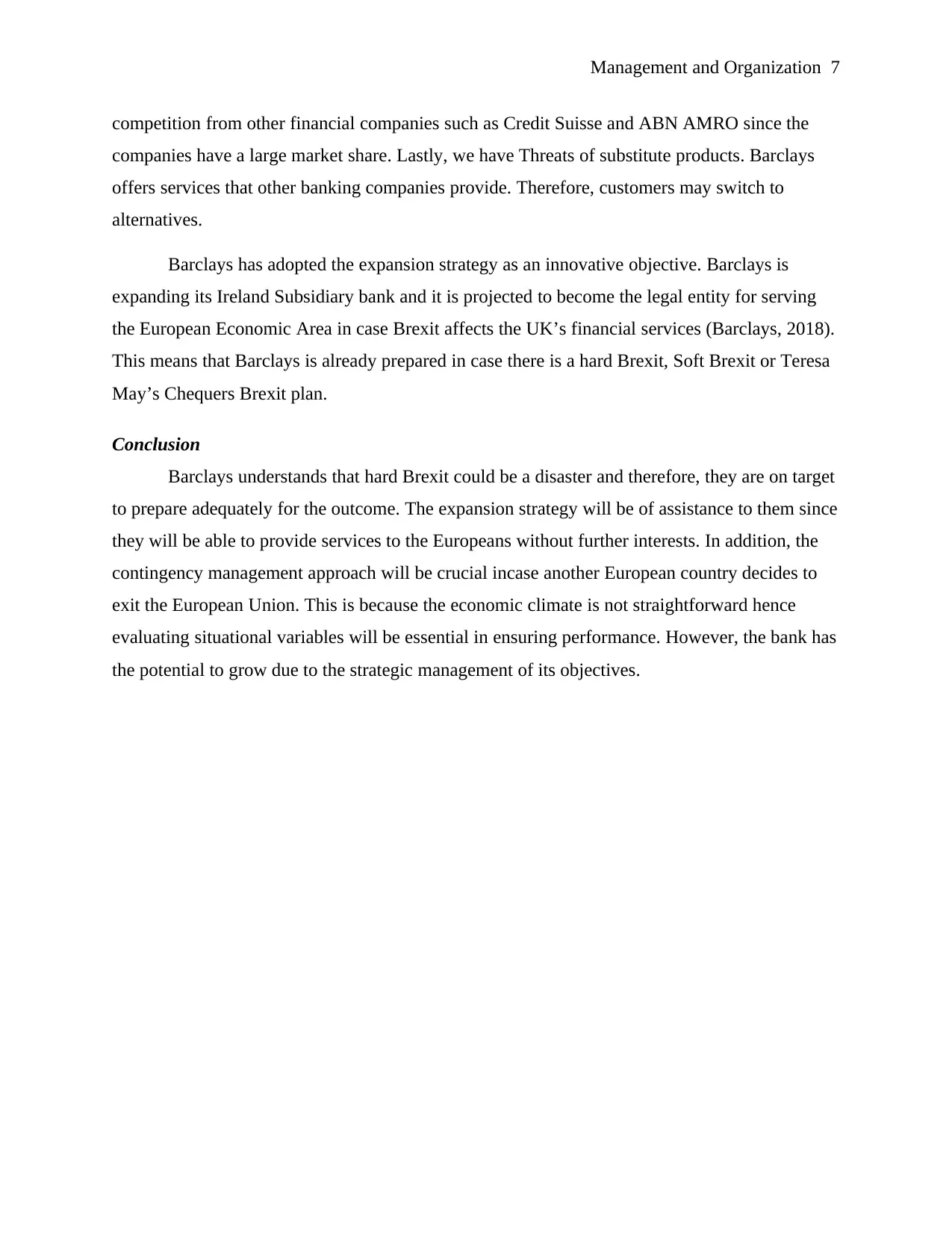
Management and Organization 7
competition from other financial companies such as Credit Suisse and ABN AMRO since the
companies have a large market share. Lastly, we have Threats of substitute products. Barclays
offers services that other banking companies provide. Therefore, customers may switch to
alternatives.
Barclays has adopted the expansion strategy as an innovative objective. Barclays is
expanding its Ireland Subsidiary bank and it is projected to become the legal entity for serving
the European Economic Area in case Brexit affects the UK’s financial services (Barclays, 2018).
This means that Barclays is already prepared in case there is a hard Brexit, Soft Brexit or Teresa
May’s Chequers Brexit plan.
Conclusion
Barclays understands that hard Brexit could be a disaster and therefore, they are on target
to prepare adequately for the outcome. The expansion strategy will be of assistance to them since
they will be able to provide services to the Europeans without further interests. In addition, the
contingency management approach will be crucial incase another European country decides to
exit the European Union. This is because the economic climate is not straightforward hence
evaluating situational variables will be essential in ensuring performance. However, the bank has
the potential to grow due to the strategic management of its objectives.
competition from other financial companies such as Credit Suisse and ABN AMRO since the
companies have a large market share. Lastly, we have Threats of substitute products. Barclays
offers services that other banking companies provide. Therefore, customers may switch to
alternatives.
Barclays has adopted the expansion strategy as an innovative objective. Barclays is
expanding its Ireland Subsidiary bank and it is projected to become the legal entity for serving
the European Economic Area in case Brexit affects the UK’s financial services (Barclays, 2018).
This means that Barclays is already prepared in case there is a hard Brexit, Soft Brexit or Teresa
May’s Chequers Brexit plan.
Conclusion
Barclays understands that hard Brexit could be a disaster and therefore, they are on target
to prepare adequately for the outcome. The expansion strategy will be of assistance to them since
they will be able to provide services to the Europeans without further interests. In addition, the
contingency management approach will be crucial incase another European country decides to
exit the European Union. This is because the economic climate is not straightforward hence
evaluating situational variables will be essential in ensuring performance. However, the bank has
the potential to grow due to the strategic management of its objectives.
Paraphrase This Document
Need a fresh take? Get an instant paraphrase of this document with our AI Paraphraser
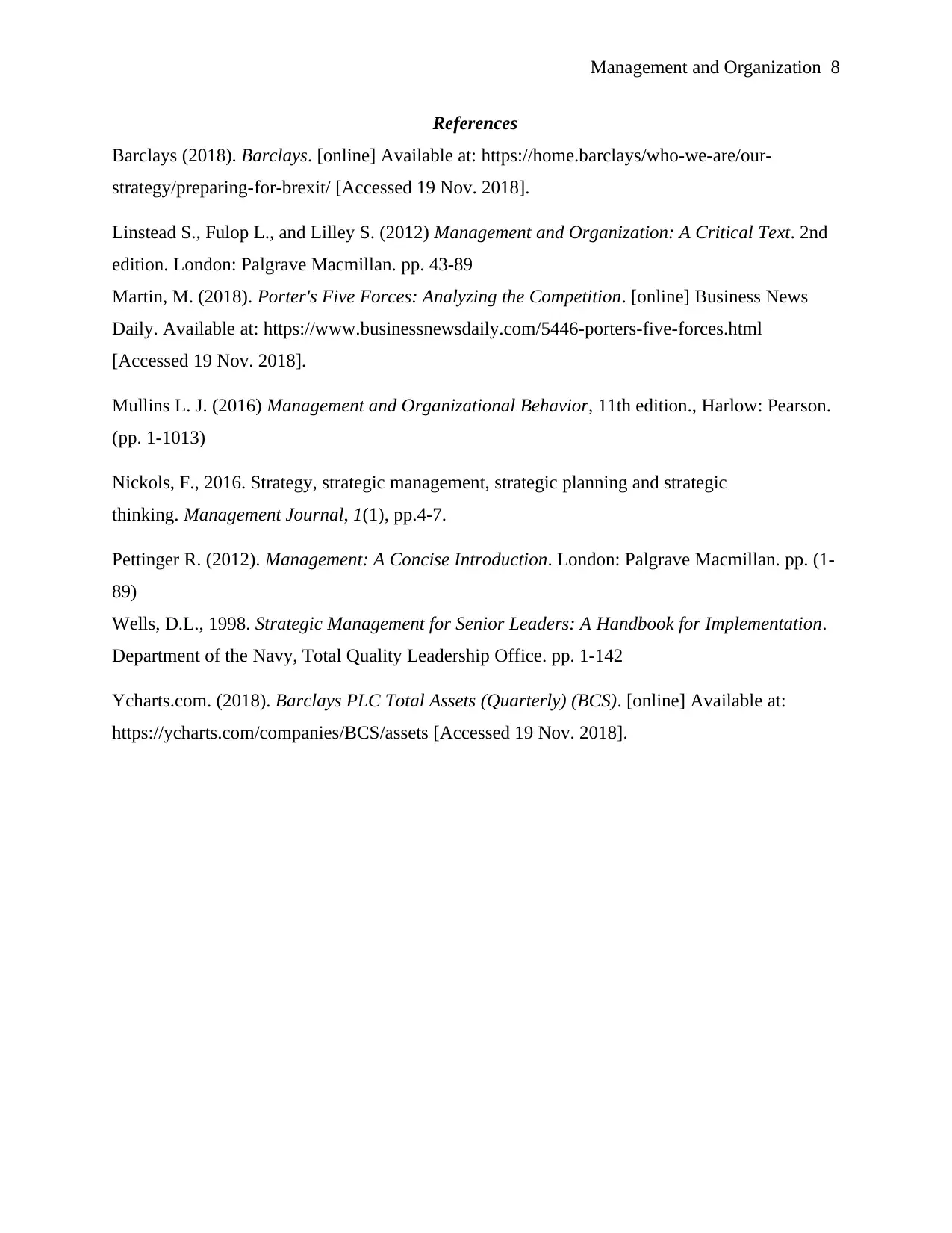
Management and Organization 8
References
Barclays (2018). Barclays. [online] Available at: https://home.barclays/who-we-are/our-
strategy/preparing-for-brexit/ [Accessed 19 Nov. 2018].
Linstead S., Fulop L., and Lilley S. (2012) Management and Organization: A Critical Text. 2nd
edition. London: Palgrave Macmillan. pp. 43-89
Martin, M. (2018). Porter's Five Forces: Analyzing the Competition. [online] Business News
Daily. Available at: https://www.businessnewsdaily.com/5446-porters-five-forces.html
[Accessed 19 Nov. 2018].
Mullins L. J. (2016) Management and Organizational Behavior, 11th edition., Harlow: Pearson.
(pp. 1-1013)
Nickols, F., 2016. Strategy, strategic management, strategic planning and strategic
thinking. Management Journal, 1(1), pp.4-7.
Pettinger R. (2012). Management: A Concise Introduction. London: Palgrave Macmillan. pp. (1-
89)
Wells, D.L., 1998. Strategic Management for Senior Leaders: A Handbook for Implementation.
Department of the Navy, Total Quality Leadership Office. pp. 1-142
Ycharts.com. (2018). Barclays PLC Total Assets (Quarterly) (BCS). [online] Available at:
https://ycharts.com/companies/BCS/assets [Accessed 19 Nov. 2018].
References
Barclays (2018). Barclays. [online] Available at: https://home.barclays/who-we-are/our-
strategy/preparing-for-brexit/ [Accessed 19 Nov. 2018].
Linstead S., Fulop L., and Lilley S. (2012) Management and Organization: A Critical Text. 2nd
edition. London: Palgrave Macmillan. pp. 43-89
Martin, M. (2018). Porter's Five Forces: Analyzing the Competition. [online] Business News
Daily. Available at: https://www.businessnewsdaily.com/5446-porters-five-forces.html
[Accessed 19 Nov. 2018].
Mullins L. J. (2016) Management and Organizational Behavior, 11th edition., Harlow: Pearson.
(pp. 1-1013)
Nickols, F., 2016. Strategy, strategic management, strategic planning and strategic
thinking. Management Journal, 1(1), pp.4-7.
Pettinger R. (2012). Management: A Concise Introduction. London: Palgrave Macmillan. pp. (1-
89)
Wells, D.L., 1998. Strategic Management for Senior Leaders: A Handbook for Implementation.
Department of the Navy, Total Quality Leadership Office. pp. 1-142
Ycharts.com. (2018). Barclays PLC Total Assets (Quarterly) (BCS). [online] Available at:
https://ycharts.com/companies/BCS/assets [Accessed 19 Nov. 2018].
1 out of 8
Related Documents
Your All-in-One AI-Powered Toolkit for Academic Success.
+13062052269
info@desklib.com
Available 24*7 on WhatsApp / Email
![[object Object]](/_next/static/media/star-bottom.7253800d.svg)
Unlock your academic potential
Copyright © 2020–2025 A2Z Services. All Rights Reserved. Developed and managed by ZUCOL.





